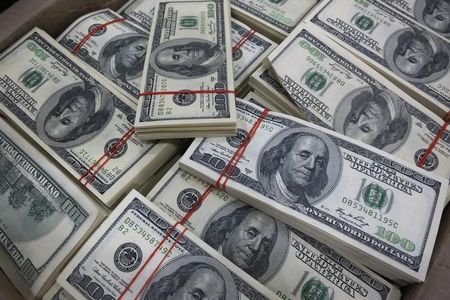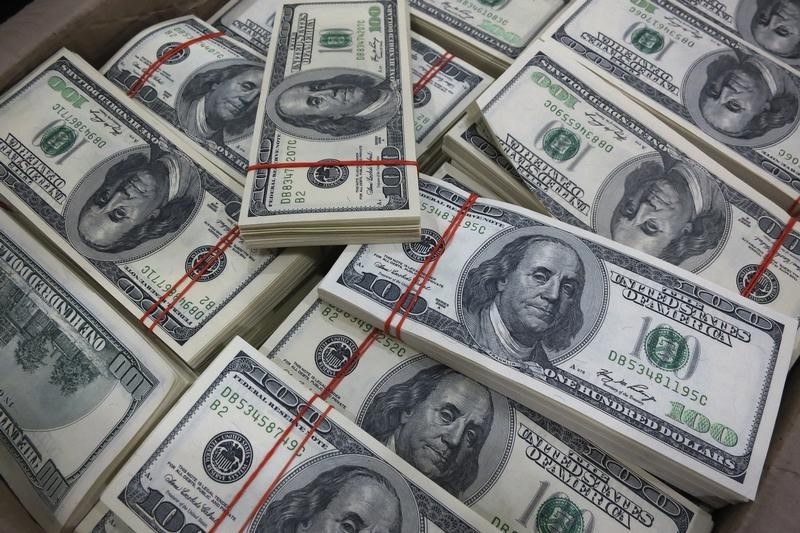Forex
Dollar retreats ahead of inflation data; Yen soars on Ueda’s comments


© Reuters.
Investing.com – The U.S. dollar fell in early European trade Monday, retreating from a six-month high, while the Japanese yen surged as comments from Bank of Japan Governor Kazuo Ueda signaled a potential change in monetary policy.
At 03:20 ET (07:20 GMT), the Dollar Index, which tracks the greenback against a basket of six other currencies, traded 0.5% lower to 104.212, falling from last week’s six-month high of 105.15.
Yen soars after Ueda hints at policy change
Dragging the lower Monday has been sharp gains in the yen, with 1.2% lower at 146.06, as BOJ head Kazuo Ueda flagged a potential pivot away from negative interest rates.
This extremely easy monetary policy has contributed significantly to the yen falling to 10-month lows against the dollar given the growing interest rate differentials.
Ueda told a local newspaper that the BOJ could have enough data by the end of the year to determine whether rates should stay negative, adding that the bank’s 2% inflation target was just in sight, allowing policymakers to begin considering tightening policy.
ECB policy meeting looms large
Elsewhere, rose 0.2% to 1.0724, climbing from last week’s three-month low as traders prepare for Thursday’s policy-setting meeting from the .
There is a great deal of uncertainty over the ECB’s rate decision as price pressures remain elevated while data shows economic activity is now slowing sharply.
The central bank has raised rates at each of its past nine meetings and policymakers are now debating whether to raise the deposit rate again, to 4%, or pause.
rose 0.4% to 1.2518, also rebounding from a three-month low hit last week, with traders keenly awaiting Tuesday’s release of July , which could see a reduction of wage inflationary pressures.
Traders eagerly await U.S. inflation data
Despite Monday’s losses, the dollar still remains near its highest levels in six months, helped by a recent run of resilient economic data which lifted expectations that further rate hikes from the Federal Reserve may be on the horizon.
U.S. data, due on Wednesday, as well as on Thursday, will be carefully studied for more cues on monetary policy and the path of interest rates.
The is widely expected to keep interest rates on hold at its meeting next week, but data showing inflation remains sticky could point to another hike later in the year.
“With activity data staying strong, it seems the market may be more minded to buy into the idea of another ‘skip’ – i.e. the Fed not hiking in September but hiking again later in the year. Clearly, this pushes the idea of a Fed easing cycle later and keeps the dollar stronger for longer,” said analysts at ING, in a note.
Chinese yuan bounces off 16-year low
fell 0.7% to 7.2920, with the yuan bouncing from Friday’s 16-year low after China’s central bank signaled increasing discomfort with the currency’s recent weakness with a strong daily midpoint guidance rate.
Positive inflation data from China over the weekend also helped as it showed some improvement in Asia’s largest economy.

 Forex3 years ago
Forex3 years agoForex Today: the dollar is gaining strength amid gloomy sentiment at the start of the Fed’s week

 Forex3 years ago
Forex3 years agoUnbiased review of Pocket Option broker

 Forex3 years ago
Forex3 years agoDollar to pound sterling exchange rate today: Pound plummeted to its lowest since 1985

 Forex3 years ago
Forex3 years agoHow is the Australian dollar doing today?

 Cryptocurrency3 years ago
Cryptocurrency3 years agoWhat happened in the crypto market – current events today

 World3 years ago
World3 years agoWhy are modern video games an art form?

 Commodities3 years ago
Commodities3 years agoCopper continues to fall in price on expectations of lower demand in China

 Economy3 years ago
Economy3 years agoCrude oil tankers double in price due to EU anti-Russian sanctions





















